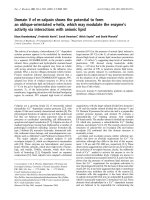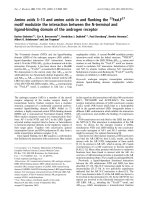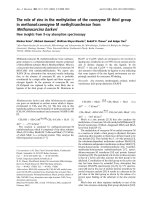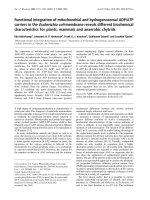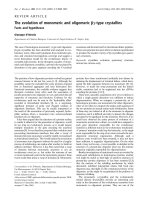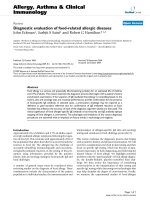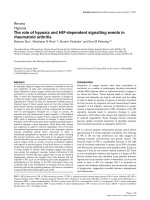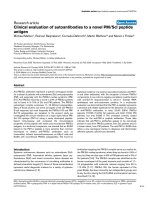Báo cáo y học: "Economic evaluation of zinc and copper use in treating acute diarrhea in children: A randomized controlled trial" ppsx
Bạn đang xem bản rút gọn của tài liệu. Xem và tải ngay bản đầy đủ của tài liệu tại đây (265.63 KB, 10 trang )
BioMed Central
Page 1 of 10
(page number not for citation purposes)
Cost Effectiveness and Resource
Allocation
Open Access
Research
Economic evaluation of zinc and copper use in treating acute
diarrhea in children: A randomized controlled trial
Archana B Patel*
1
, Leena A Dhande
2
and Manwar S Rawat
3
Address:
1
Clinical Epidemiology Unit, Indira Gandhi Medical College, Central Avenue, Nagpur India,
2
Government Medical College, Nagpur,
India and
3
Nagpur Municipal Corporation health and Family Center Nagpur, India
Email: Archana B Patel* - ; Leena A Dhande - ;
Manwar S Rawat -
* Corresponding author
zinccoppermicronutrientacute diarrheaand cost-effectiveness
Abstract
Background: The therapeutic effects of zinc and copper in reducing diarrheal morbidity have
important cost implications. This health services research study evaluated the cost of treating a
child with acute diarrhea in the hospital, the impact of micronutrient supplementation on the mean
predicted costs and its cost-effectiveness as compared to using only standard oral rehydration
solution (ORS), from the patient's and government's (providers) perspective.
Methods: Children aged 6 months to 59 months with acute diarrhea were randomly assigned to
receive either the intervention or control. The intervention was a daily dose of 40 mg of zinc sulfate
and 5 mg of copper sulfate powder dissolved in a liter of standard ORS (n = 102). The control was
50 mg of standard ORS powder dissolved in a liter of standard ORS (n = 98). The cost measures
were the total mean cost of treating acute diarrhea, which included the direct medical, the direct
non-medical and the indirect costs. The effectiveness measures were the probability of diarrhea
lasting ≤ 4 days, the disability adjusted life years (DALYs) and mortality.
Results: The mean total cost of treating a child with acute diarrhea was US $14 of which the
government incurred an expenditure of 66%. The factors that increased the total were the number
of stools before admission (p = 0.01), fever (p = 0.01), increasing grade of dehydration (p = 0.00),
use of antibiotics (p = 0.00), use of intra-venous fluids (p = 0.00), hours taken to rehydrate a child
(p = 0.00), the amount of oral rehydration fluid used (p = 0.00), presence of any complications (p
= 0.00) and the hospital stay (p = 0.00). The supplemented group had a 8% lower cost of treating
acute diarrhea, their cost per unit health (diarrhea lasting ≤ 4 days) was 24% less and the
incremental cost-effectiveness ratio indicated cost savings (in Rupees) with the intervention [-452;
95%CI (-11306, 3410)]. However these differences failed to reach conventional levels of
significance.
Conclusion: An emphasis on the costs and economic benefits of an alternative therapy is an
important aspect of health services research. The cost savings and the attractive cost-effectiveness
indicates the need to further assess the role of micronutrients such as zinc and copper in the
treatment of acute diarrhea in a larger and more varied population.
Published: 29 August 2003
Cost Effectiveness and Resource Allocation 2003, 1:7
Received: 29 July 2003
Accepted: 29 August 2003
This article is available from: />© 2003 Patel et al; licensee BioMed Central Ltd. This is an Open Access article: verbatim copying and redistribution of this article are permitted in all
media for any purpose, provided this notice is preserved along with the article's original URL.
Cost Effectiveness and Resource Allocation 2003, 1 />Page 2 of 10
(page number not for citation purposes)
Background
Diarrhea remains a major cause of morbidity and mortal-
ity in developing countries with a significant proportion
experiencing a depletion of zinc and copper micronutri-
ent stores. Community-based randomized controlled tri-
als have shown a beneficial effect of zinc supplementation
in reducing the severity and duration of diarrhea. How-
ever zinc supplementation has the potential to aggravate
marginal copper deficiency, which in turn may impact
negatively on the diarrheal morbidity [1]. This health
services research study evaluated the economic impact
and benefits of zinc and copper supplementation for
treatment of acute diarrhea in a randomized, double
blind, clinical trial.
The magnitude of the therapeutic effects of these micronu-
trient supplementation in reducing either the duration or
the severity of diarrhea could compare favorably with
other health interventions being implemented in devel-
oping countries to improve child health and survival. A
decrease in severity and duration reduces costs, which
may partly or totally, in the case of a dominant interven-
tion, offset the costs of supplementation and also improve
quality of life. Adding supplements of micronutrients to
the standard management of diarrhea requires a change in
treatment practices. Although this appears to be minimal
and feasible from a cost perspective, in the face of limited
resources, the effectiveness of this intervention must be
considered to ensure that the opportunity costs incurred
are minimized.
To date the cost-effectiveness of zinc and copper supple-
mentation in the treatment of diarrhea has not been
established. An essential element of this research is there-
fore to ascertain the efficiency of this supplementation. It
is hypothesized that zinc and copper supplementation for
treatment of acute diarrhea will be dominant compared to
standard treatment from the provider's and patient's per-
spective (i.e. it will be both more efficacious and less
costly). Our research questions were : What does it cost to
treat a child of acute diarrhea in the hospital? Does the
supplementation of zinc and copper to the oral rehydra-
tion solution (ORS) have an impact on the mean pre-
dicted costs of treating acute diarrhea and what is its
incremental costs-effectiveness as compared to standard
ORS?
Methods
Patient enrollment
This is a clinical trial that evaluated the therapeutic effect
of zinc and copper supplementation added to standard
oral rehydration solution (ORS) for treating acute
diarrhea at the Nagpur city's Government Medical College
and Hospital, India. This study was conducted in children
aged 6 months to 59 months who presented to the hospi-
tal with more than three unformed stools in 24 hours and
diarrheal duration of < 7 days. Any child with intractable
vomiting, pre-renal or renal failure, respiratory distress,
altered sensorium or any such co-morbid condition that
precludes the use of oral rehydration solution (ORS) were
excluded from the trial. Children with clinical signs of
severe malnutrition such as kwashiorkor and marasmus
were also excluded. Baseline assessment included
diarrheal duration, character of the stool, degree of dehy-
dration, age, gender, maternal education, number of chil-
dren in the family, monthly parental income, diet of the
child, immunization status, history of fever or vomiting,
prior use of ORS, prior use of medications and the nutri-
tional status. Children who had severe dehydration or
inability to drink were temporarily excluded for 4 hours
during which they received standard treatment. At the end
of this time period they were reassessed for possible inclu-
sion in the trial.
Intervention
The treatment was randomized at an individual level
using a fixed randomization scheme with equal allocation
of patients to the intervention and control group. The
patients and the caregivers were blinded to the subject's
treatment status. Two identical coded waterproof sachets
of the intervention or the control were administered to the
treatment and the control group only once in a day. The
intervention sachet contained 40 mg of Zinc sulfate and 5
mg of Copper sulfate powder. The control sachet con-
tained 50 mg of standard ORS powder. These sachets were
dissolved in one liter of ORS by the nurse. Each day a fresh
solution was prepared till the diarrheal episode lasted.
The children were encouraged to take their routine feeds.
Patients were also provided with other usual supportive
care with antipyretics and antibiotics for bloody diarrhea.
Children needing intravenous fluids were randomized
after they were able to take orally. If a child was dehy-
drated after 6 hours of oral rehydration or if signs of severe
dehydration appeared despite appropriate ORS adminis-
tration then they were administered intravenous fluids
and this was recorded as an "unscheduled intravenous
fluid".
Measurement of clinical outcomes
The children were assessed at the same time every 24
hours till discharge. The time taken to rehydrate the child
from time of admission, episodes of vomiting, use of
intravenous fluids during rehydration and the use of
unscheduled intravenous fluids during the maintenance
of hydration was measured daily. Any complications such
as pre-renal or renal failure, convulsions, electrolyte
imbalance, bronchopneumonia and septicemia were
recorded. The use of other medication such as antibiotics
was also recorded. Weight was recorded on admission and
at discharge. A child was discontinued from the study if
Cost Effectiveness and Resource Allocation 2003, 1 />Page 3 of 10
(page number not for citation purposes)
the child experienced any of the above complications,
died or if the parent withdrew consent.
The primary clinical outcome was the duration of diarrhea
from the time of onset. A diarrheal day was defined as a
24-hour period with passage of at least four unformed
stools and this episode was considered terminated on the
last day of diarrhea followed by a 24-hour diarrheal free
period. The number and proportion of patients with
diarrhea > 4 days and the mean length of hospital stay was
also estimated. The proportion of children with diarrhea
> 4 days was estimated based on the results of the Indian
community-based study of zinc supplementation, which
indicated that the reduction in the duration of diarrhea
was evident on the fourth day [2].
The severity of diarrhea was measured by the use of
unscheduled intravenous fluids expressed as the number
of subjects who received intravenous fluid at any time
after randomization, weight loss at discharge, presence of
complications or mortality.
Identifying and Measuring Costs
The cost data was collected to identify the direct medical,
the direct non-medical and the indirect costs [3]. We used
the actual financial and not economic costs and the rupee
was valued in the year 1996 (1$ = Rs. 36). The price paid
for a service is a good reflection of the costs of producing
the service in competitive markets which prevent both
excess profits and negative expected profits [4]. Average
variable costs were measured as a proxy for true marginal
costs.
The resources utilized for the management of acute
diarrhea and their unit costs were measured in order to
determine three categories of costs (direct medical costs,
direct non-medical costs, and indirect costs). We enumer-
ated every input consumed by the patient and then its unit
cost. This is known as "micro-costing"[5]. The direct med-
ical costs were calculated from the patient's and the gov-
ernment (provider's) perspective. The measurement of the
resources utilized was from the time of onset of diarrhea
and during the study period. The direct medical cost to the
patient included any out of pocket expenditures for med-
icines or the fees paid to the physician prior to seeking
treatment at the government hospital. The direct medical
cost to the ministry of health was the expenditure incurred
by the hospital administration after randomization. The
direct non-medical and the indirect costs were from the
patient's perspective. The protocol-driven costs were
deducted from the total costs. The resource utilization was
measured in a standard case-report form.
The direct medical costs included the services provided by
the medical personnel, the medications, the type of serv-
ice provided (general or intensive care) and the laboratory
investigations. In the United States hospital cost account-
ing systems (data base for Disease related groups or DRGs,
cost to charge ratios, etc) reimbursement systems for man-
aged care and insurance allow assignment of costs to
resources used, a process known as "gross accounting" [6].
In India, there is no established database of costs of med-
ical services, investigations and the cost of hospital stay.
These costs vary with respect to the type of medical serv-
ices and hospital category. The government hospitals are
subsidized, the charges at private and corporate hospitals
overestimate costs whereas charges to the patients in non-
for-profit hospitals are most likely to resemble the true
costs. The unit charges account for the unit costs of the
medical service rendered, the overhead and the adminis-
trative costs of that medical service and that of the sup-
porting units. We calculated the unit costs of each patient
visit at the outpatient clinic from the salaries of the staff
working at this clinic times the proportion of their time
spent rendering out-patient services, divided by the aver-
age number of attending patients. The cost was 1.5 times
the amount actually charged to the patient by the govern-
ment and resembled the cost structure of the non-for-
profit-hospitals. We therefore verified the other direct
medical costs calculated by us by comparing it to the
charges of non-profit hospitals. Similarly the cost of a
day's stay for a patient, at the diarrhea treatment and train-
ing center or at the hospital ward, was calculated by sum-
ming the average per diem cost of stay in with the daily
average per-patient labor charges of the doctors, the
nurses and ward attendants. The per diem cost included
the cost of subsidized meals. We estimated laboratory
investigations in consultation with the laboratory admin-
istrators based on average labor costs of technicians, the
costs of supplies, overheads and administration. The costs
of drugs were the manufacture's wholesale price.
The direct non-medical cost of traveling to the physician
or the hospital for the patient and the family, cost of food
to the family and patient (only if it were not included in
the per-diem hospital stay cost) during hospitalization
and other incidental cost to the family but attributed to
the illness were measured.
The indirect costs were measured by the wages lost of
employed parents or guardians attending to the child with
diarrhea. This is a conservative estimation, as monetary
value is not assigned for the loss time of unemployed par-
ents. We did not estimate intangible costs like pain, suffer-
ing and lost of leisure time.
Economic analysis
The mean (± SD) of the direct medical costs and its cost
components such as the visit fees, costs of antibiotics, of
intravenous fluids, of laboratory tests, of ORS, of length of
Cost Effectiveness and Resource Allocation 2003, 1 />Page 4 of 10
(page number not for citation purposes)
stay in the hospital, of out-patient visits were estimated.
We also calculated the mean (± SD) of the direct non-
medical and indirect costs in the study groups. The mean
(± SD) of the total costs in the study groups was deter-
mined and the univariate and multivariate linear regres-
sion was used to determine the impact of the
interventions, the pre and post randomization variables
in predicting the total mean costs.
The cost-effectiveness of trace minerals was determined by
1) the total cost (Rs) per case of diarrhea > 4 days averted,
2) the total cost per death averted, and 3) the incremental
cost effectiveness ratio (ICER), which is the ratio of differ-
ence (of the intervention and the control group) in total
mean of costs in the numerator and the difference in the
proportion of patients of diarrhea less than four days in
the denominator. We constructed the 95% confidence
intervals for the incremental cost effectiveness ratio. We
used the non-parametric boot-strap method to assess the
normality of this ratio and then constructed the confi-
dence intervals [6].
We also calculated the ratio of the total mean cost and the
mean number of patients with diarrhea less than 4 days
(CE) for the intervention and the control group for the
boot strap sample. This measured the mean cost per
patient cured less that 4 days in each group. We then
measured the relative cost-effectiveness (RCE) of the treat-
ment group relative to that of the control with its 95%
confidence intervals (CE
treatment
/ CE
control
). STATA Version
5 was used for these statistical analyses.
Table 1: Base-line Demogrpahic Characteristics and Features of the Diarrheal Episode with Respect to Study Group*
Characteristics Treatment group (N = 102) Control (N = 98) P value
Age in months 21.2 ± 14.2 21.4 ± 13.7 0.8
Male sex (%) 58.8 48.9 0.16
Monthly income Rs.1497 ± 1719 Rs.1436 ± 1428 0.62
No. of children in the family 2.0 ± 0.9 2.1 ± 0.9 0.4
Educational status of mother
Illiterate(%) 12.7 23.4 0.11
Primary 7.8 12.2
Middle 14.7 14.2
High 42.1 37.7
College 22.5 12.2
Child's diet (%)
Predominantly breast fed 15.6 21.4 0.4
Predominantly formula fed 5 3
Both 1 3
Other solid foods 78.4 72.6
Immunization status (%)
Unimmunized 3.9 7.1 0.4
Incomplete 14.7 10.2
Complete 81.3 82.6
Weight (KG) 8.2 ± 2.2 7.8 ± 2.1 0.2
Height (CMS) 77.3 ± 10.9 75.8 ± 9.9 0.3
Wasting (%) 58.2 51 0.3
Duration of diarrhea before enrollment(days) 2.2 ± 1.4 2.2 ± 1.3 0.8
No. of stools in the previous 24 hr 9.9 ± 6.3 9.3 ± 7.1 0.5
Vomiting in 24 hr before enrollment (%) 61.7 55.1 0.3
Fever during this episode(%) 39.2 37.6 0.8
Dehydration (%)
No 85.2 82.6 0.8
Some 11.7 14.2
Severe 2.9 3
Type of stool
Watery or mucoid 89.3 87.8 0.2
Bloody 10.7 12.2
Hospitalized (%) 57.8 66 0.2
* Plus-minus values are mean ± SD
Cost Effectiveness and Resource Allocation 2003, 1 />Page 5 of 10
(page number not for citation purposes)
Disability adjusted life years (DALYs) are an indicator of
the time lived with a disability and the time lost due to
premature mortality [7]. This was calculated for all chil-
dren in the study using their actual age, the number of
days spent with diarrhea, and disability weights ranging
from 0.4 to 0.6 (based on the severity of illness) with
death weighted as 1. The discount rate was 5 %. We then
calculated the mean (± SD) of DALYs lost in the two study
groups.
Results
Clinical Outcomes
A total of 220 children (non-participation rate was 9 %)
were enrolled in the study and were randomized to treat-
ment (n = 102) and control (n = 98) groups. The baseline
characteristics of the children in the two groups were sim-
ilar (Table 1). The health outcomes in the study group
were favorable but failed to reach significant levels. The
study group also showed clinically important reductions
in rate of complications and mortality (Table 2).
Costs and Effectiveness Outcomes
The average total cost of treating a patient with acute
diarrhea was Rs. 500 (US$14). The patient and their fam-
ilies incurred 34% (direct medical cost: 4%, direct non-
medical cost: 20%, and, the indirect cost: 10%) and the
government incurred 66% of the total cost of treating a
patient with acute diarrhea (Table 3). The mean cost of
treating diarrhea incurred by the patient and the ministry
of health in the treatment and the control group were not
significantly different. Similarly the mean non-medical
costs, the indirect costs and the total costs (medical, non-
medical and the indirect costs) were similar in both
groups (Table 3).
Univariate analysis showed that increasing age (p = 0.03),
weight (p = 0.001), height (p = 0.002), and mid-arm cir-
cumference (p = 0.001), the intake of solid foods (p =
0.07), and if the child was completely immunized (p <
0.001) were associated with lower mean total cost for
treating acute diarrhea. The variables that increased mean
total costs were the number of stools before admission (p
= 0.01), fever (p = 0.01), increasing grade of dehydration
Table 2: Clinical outcomes in the treatment and control group.
Health Outcomes Treatment Control Odds ratio [95%CI] P value
Mean duration of diarrhea (m ± SE) 4.34 ± 0.2 4.48 ± 0.2 0.3
Length of hospital stay (m ± SE) 1.6 ± 0.2 2 ± 0.2 0.2
Diarrhea > 4 days (%) 39 46 0.83 (0.63, 1.1) 0.2
Unscheduled IV use(%) 2 5 0.37 (0.07, 1.9) 0.2
Weight loss(%) 34 44 0.7 (0.4, 1.2) 0.2
Complications 1 6 0.15 (0.02, 1.2) 0.05
Mortality 0 2
Table 3: The costs incurred in treating patients of acute diarrhea in treatment and control group, in Rupees (1$ = 36 Rs, 1996)
Cost Components Treatment (mean ± SE) Control (mean ± SE) P value
Direct medical cost (Patient) 23.6 ± 7 17.3 ± 6 0.5
- Visiting fees 15.9 ± 6 6.9 ± 5 0.2
- Medicines 8 ± 4 9.1 ± 5 0.5
Direct medical cost(Government) 309.4 ± 34 351.7 ± 39 0.4
- Cost of out-patient visits 3.5 ± 1 2.6 ± 1 0.2
- Cost of hospital stay 195.3 ± 25 238.7 ± 32 0.2
- Cost of ORS used 15.7 ± 6 15 ± 4 0.7
- Cost of antibiotics used 11.1 ± 4 18.6 ± 6 0.4
- Cost of Intravenous fluids used 10.8 ± 3 17.7 ± 6 0.3
- Cost of laboratory test 90.2 ± 11 93.4 ± 9 0.6
Direct non-medical cost 100.7 ± 11 97.5 ± 12 0.7
- Travel costs 85.9 ± 10 76.8 ± 8 0.4
- Other costs 14.7 ± 4 20.7 ± 6 0.3
Indirect costs 47.5 ± 11 53.9 ± 12 0.7
Total cost of diarrhea 481.25 ± 44 520.6 ± 54 0.6
Cost Effectiveness and Resource Allocation 2003, 1 />Page 6 of 10
(page number not for citation purposes)
(p < 0.001), use of antibiotics (p < 0.001), use of intra-
venous fluids (p < 0.001), hours taken to rehydrate a child
(p < 0.001), the amount of oral rehydration fluid used (p
< 0.001), presence of any complications (p < 0.001) and
the hospital stay (p < 0.001). The best subset linear regres-
sion showed that there was a reduction in total cost by the
use of micronutrients but failed to reach levels of signifi-
cance (Table 4).
Th cost-effectiveness of the treatment is shown in Table 5.
Boot-strap method was used to estimate the robustness of
these estimates. The bootstrap estimate of the total mean
cost of treatment group [Rs. 481; 95% CI (403, 577) ver-
sus Rs. 521; 95%CI (425, 623)] was less and the effect size
of diarrhea ≤ 4 days was larger [63; 95%CI (52, 72) versus
52; 95%CI (42, 61)]. The intervention was dominant,
with net cost saving of Rs. 40 and a net health gain 9 cases
of diarrhea >4 days averted, but failed to reach level of sta-
tistical significance. The bootstrap re-sampling (1000
times) of incremental cost effectiveness ratio (ICER)
showed a normal distribution (Figure 1). The cost-effec-
tiveness plane and the scatter of the boot strap estimates
of the ratio of cost difference and the effect difference are
shown in Figure 2. Although the scatter overlapped zero it
tended to be predominantly in the quadrant where the
treatment group dominates (i.e. less cost and better
effects). Similarly the relative cost effectiveness (RCE)
0.76 (95% CI 0.5,1), i.e. the cost per patient with diarrhea
less than 4 days, was 24% less in the group with micronu-
trient supplementation. The DALY's lost due to two
deaths in the control group were 32.6 and 34.6. The
DALYs (m; 95% CI) lost in the remaining patients of the
treatment group (2.3; 2.1, 2.4) and control group (2.4;
2.2,2.5), showed a difference of 0.1.
Discussion
Oral rehydration therapy (ORT) is a well established and
a cost-effective strategy for reducing diarrheal mortality
[8]. It is also widely accepted. Micronutrient mix or trace
minerals during the diarrheal episode could be of benefit
in reducing not only case fatality rate but also diarrheal
duration and morbidity. Any changes recommended in
the composition of ORS from its traditional constituents
to include trace minerals needs reasonable justification in
terms of efficacy and costs. Our study showed that micro-
nutrient supplementation had beneficial effects on rate of
complications and mortality. Although it reduced the
proportion of patients with diarrhea ≤ 4 days it failed to
reach traditional significance levels. However this had
important costs implications.
There is substantial variability in the costs of treating acute
diarrhea between different countries. In India, there is lit-
tle information on the costs associated with acute
diarrhea. In this study, the cost of treating acute diarrhea
was $14 per episode in children attending a government
hospital where the government spent 66% of the costs per
child. The average cost of treating diarrhea documented in
another study in rural India in 1985–88 was $1.25 with a
range of $0.13–$2.7 [9]. If the costs of treatment in this
Table 4: Predictors of total cost of treating acute diarrhea on best subset Linear regression
Variables Coefficient Std Error Student's T P value
Treatment -19.1 28.7 -0.66 0.5
Age ≥ 1 yr. -13.6 13.9 -0.98 0.3
Complications 25.6 15.9 1.6 0.10
Dehydration 166.1 40 4.14 0.000
Total stool output -0.02 0.01 -1.45 0.14
Use of IV fluids 131.1 88.5 1.48 0.14
Length of hospital stay 154.8 8.1 18.9 0.000
Table 5: Cost-effectiveness of trace minerals
Treatment (A) Control (B) Change in condition (A-B)
No. of cases averted (diarrhea > 4 days) 63 52 -9
No. of deaths 0 2 - 2
Total cost 481 521 - 40
Cost-effectiveness
Rs. per case averted - 4.4
Rs. per death averted - 20
Cost Effectiveness and Resource Allocation 2003, 1 />Page 7 of 10
(page number not for citation purposes)
study are discounted for a 10 year period with an infla-
tion-adjusted discount rate of 20% (average inflation rate
of 7 % and discount rate of 12% = 1.7 × 1.12 = 1.198 or
19.8%), the present value would be $2 (in 1986) as com-
pared to $1.25 [10]. This was a hospital-based study with
sicker children and therefore the cost of treatment is likely
to be more. In Indonesia the average costs was $2.27 per
child of which the community paid 46% [11]. In the
United States the cost was US$289 per episode in <36-
month old ambulatory population and the costs of hospi-
talization of 250,000 patients was US$ 560 million or
$2240 per case. The contribution of direct medical costs
(costs of medical services, medications and laboratory
services), of travel costs and of indirect costs (missed
work) in our study were 70%, 16% and 10% respectively
as compared to 39%, 5% and 49% in <36-month old
ambulatory population with acute diarrhea in the United
States, showing vast variations in costs and their types
between these two settings. The cost of treatment in
developing countries is considerably less because of
diverse health care systems, different hospital capacity,
their scope and their sources of funding, price
discrimination by pharmaceuticals and differences in the
per capita income, which impacts on their medical care
spending [14–16].
The severity of the illness, i.e. the grade of dehydration
and the length of hospital stay were the most important
predictors of total cost. Hospitalization accounted for
62% of the direct medical costs and is comparable to costs
of rotavirus hospitalizations described by Tucker et al
[17]. It costs less to treat well-nourished immunized chil-
dren since these children are less likely to experience a
severe episode requiring hospitalization. As expected, the
use of intravenous fluids and antibiotics inflated the costs
of treatment.
The total costs of treatment in the intervention group were
8% less than the total costs in the control group. There
was a reduction of 8% in costs of hospitalization and a 6%
reduction in costs of antibiotics in the supplemented
group. Although these differences failed to reach cinven-
tional levels of significance, they translate into large
national savings. The under-five population in India expe-
riences 105 million episodes per year, of which 15–22.5
million are moderate to severe diarrheal episodes [18].
The mean cost of treating diarrhea was $14. Hence the
Distribution of the ratio: total cost difference/effect difference (icer)Figure 1
Distribution of the ratio: total cost difference/effect difference (icer).
Cost Effectiveness and Resource Allocation 2003, 1 />Page 8 of 10
(page number not for citation purposes)
burden of medical costs per year would be $1.47 billion
and an 8% saving would be $117.6 million. According to
estimates from the United States, acute intestinal infec-
tious diseases amount to a minimum of $23 billion a year
which includes loss of productivity ($21.76 billion) and
medical costs ($1.25 billion)[13]. We do not have esti-
mates of loss of productivity caused by acute diarrhea in
India.
The cost-effectiveness ratio (the incremental costs and
effects of adding micronutrients to ORS) was calculated as
the difference in costs between the two alternatives (net
costs) divided by the difference in health outcomes (net
effectiveness) [19]. The unit of health of interest and the
effectiveness measure for this study was the proportion of
children with diarrhea ≤ 4 days, since mortality is an infre-
quent outcome and would require a large sample size. We
believe that it is a pragmatic and good proxy measure for
diarrheal morbidity and mortality for assessing cost-effec-
tiveness. The incremental cost-effectiveness estimate was
negative because of the savings in the total costs of treat-
ment with fewer morbid events. The intervention was not
only more cost-effective, but it paid for itself. The cost per
unit health with the use of trace minerals in ORS was 24%
less than when only ORS was used. Therefore it could be
judged as a more cost-effective intervention. These data
were stochastic and not deterministic, i.e. both costs and
effects were determined from data sampled from the same
patients in a study. A sensitivity analysis or the confidence
interval of the results helps to determine its robustness
and its performance in a dynamic environment, where
variations in costs and benefits occur due to variation in
measurements and implementation of the intervention
[20]. We determined the 95% confidence interval for the
incremental cost-effectiveness ratio (ICER) using the non-
parametric bootstrap method [21]. The CI yielded the
magnitude of the observed difference, which favored the
intervention because 62% of the bootstrap replications
were in the quadrant where the treatment with the supple-
ments dominated.
1000 bootstrap re-samples – cost-effectiveness planeFigure 2
1000 bootstrap re-samples – cost-effectiveness plane.
Cost Effectiveness and Resource Allocation 2003, 1 />Page 9 of 10
(page number not for citation purposes)
The effectiveness of the intervention was also measured in
the number of DALYs. The loss of DALYs from morbidity
was 0.1 and from mortality was 33.6 because of two
deaths in the control group. A DALY translates into 481
episodes of acute diarrhea [22]. Therefore a saving of 0.1
DALY by using the micronutrients along with ORT saves
48 episodes of diarrhea and its costs.
This study had several limitations. The resources used
were measured from the start of diarrhea and during the
hospital stay. It did not capture downstream resources
such as re-hospitalization or resources used after dis-
charge of the treatment or the disease. Therefore the total
cost of acute diarrhea in this study may have been under-
estimated. Also an assumption was that the course of the
patient's illness in the intervention group would be no dif-
ferent from that in routine care after discharge. Secondly,
the measurement of the outcome in the study i.e. the pro-
portion of diarrhea ≤ 4 days, is an intermediate and a
proxy measure of diarrheal morbidity. Mortality is a defi-
nite outcome and perhaps the gold standard in terms of
measurement. However the very large sample size needed
for this outcome was not feasible. Though the outcome in
this study was a pragmatic one it may restrict the general-
izability and external validity of the study.
Although there were substantial economic cost savings,
there were no statistical differences in costs and effects
when tested to the null hypothesis. Medical cost data tend
to be skewed in distribution with no ceiling effects on out-
liers. Appropriate transformations of the data are difficult.
The heterogeneity of data on resource use is such that to
show a difference between two groups for the same level
of type I error (p < 0.05), a much larger sample size is
needed for the economic question than for the clinical
question [20,23]. However decision maker's preferences
regarding acceptable levels of risks for inferential error
(type I error) in economic data may vary.
In conclusion, this study shows that the cost of treating
acute diarrhoea in the developing world was less than in
the developed countries and dependant on its severity.
There was a reduction of 8% in costs of hospitalization
and a 6% reduction in costs of antibiotics in the
supplemented group which translated into large national
savings. Favorable economic outcomes were observed
with the use of trace minerals, which may have failed to
reach these traditional levels of significance for the want
of a larger sample. Therefore it is important that there is a
further assessment of their use in a larger and more varied
population.
Authors' contributions
AP participated in the design of the study, its coordina-
tion, performed the statistical analysis and drafted the
manuscript. LD participated in study design and per-
formed the data collection. MSR conceived of the study,
participated in its design and coordination. All authors
read and approved the final manuscript.
Meeting where paper was presented
INCLEN (International Clinical Epidemiology Network)
Global Meeting XV Querétaro, Mexico 1998.
Acknowledgments
We thank the management, the pediatric department and the clinical Epi-
demiology unit of Government Medical College, Nagpur, India for assisting
in the data collection and data management. We are thankful to the patients
and their parents for their participation in the trial. Finally we thank the
International Clinical Epidemiology Network who funded the writing of this
manuscript under the able guidance of Dr. Stephen Walter and Dr. Kate
D'este at University of Newcastle, Australia.
References
1. Allen LH: Zinc and micronutrient supplements for children.
Am J Clin Nutr 1998, 68:495S-498S.
2. Sazawal S, Black RE, Bhan MK, Ghandari N, Sinha A and Jalla S: Zinc
supplementation in young children with acute diarrhoea in
India. N Engl J Med 1995, 333:839-44.
3. Drummond MF, Stoddart GL and Torrance GW: Methods for the
economic evaluation of health care programmes. Oxford,
Oxford University Press; 1990:21-25.
4. Manheim LM: Health services research clinical trials. Issues in
the evaluation of economic costs and benefits. Controlled Clini-
cal Trials 1998, 19:149-158.
5. Luce BR, Manning WG, Seigel JE and Lipscomb L: Estimating Costs
in Cost-Effecitveness Analysis. In: Cost-Effectiveness in Health and
Medicin Edited by: Gold MR, Siegel JE, Russel LB, Weinstein MC. New
York, Oxford University Press; 1996.
6. Briggs A and Fenn P: Confidence intervals or surfaces? Uncer-
tainty on the cost-effectiveness plane. Health Econ 1998,
7:723-740.
7. Murray CJL: Quantifying the burden of disease : the technical
basis for disability-adjusted life years. Bull World Health Organ
1994, 72:439-445.
8. Gutiérrez GR, Tapia-Conyer R, Guiscafré H, Reyes H, Martinez H and
Kumate J: Impact of oral rehydration and selected public
health interventions on reduction of mortality from child-
hood diarrheal diseases in Mexico. Bull World Health Organ 1996,
74:189-197.
9. Balaji LN and Court A: Epidemiology of acute diarrhea in chil-
dren, its policy implications and management. Bulletin of sub-
speciality chapter of pediatric gastroenterology of Indian Academy of
Pediatrics 2000, 1:3-5.
10. Drummond MF, Stoddart GL and Torrance GW: Methods for the
economic evaluation of health care programmes. Oxford,
Oxford University Press; 1990:49-52.
11. Lerman SJ, Shepard DS and Cash RA: Treatment of diarrhea in
Indonesian children: what it costs and who pays for it. Lancet
1985, 21:651-654.
12. Avendano P, Matson DO, Long J, Whitney S, Matson CC and Picker-
ing LK: Costs associated with office visits for diarrhea in
infants and toddlers. Pediatr Infect Dis J 1993, 12:897-902.
13. Garthright WE, Archer DL and Kvenberg JE: Estimates of inci-
dence and costs of intestinal infectious diseases in the United
States. Public Health Rep 1988, 1003:107-115.
14. Phelps CE: International comparisons of health care systems.
In: Health Economics New York, Harper Collins Publishers Inc;
1992:483-509.
15. Mohaghan MJ and Mohaghan MS: Do market components
account for higher U.S. prescription prices? Ann Pharmacother
1996, 30:1489-1494.
16. Phelps CE: International comparisons of health care systems.
In: Health Economics New York, Harper Collins Publishers Inc;
1992:234-235.
Publish with Bio Med Central and every
scientist can read your work free of charge
"BioMed Central will be the most significant development for
disseminating the results of biomedical research in our lifetime."
Sir Paul Nurse, Cancer Research UK
Your research papers will be:
available free of charge to the entire biomedical community
peer reviewed and published immediately upon acceptance
cited in PubMed and archived on PubMed Central
yours — you keep the copyright
Submit your manuscript here:
/>BioMedcentral
Cost Effectiveness and Resource Allocation 2003, 1 />Page 10 of 10
(page number not for citation purposes)
17. Tucker AW, Haddix AC, Brease JS, Holman MS, Parashe UD and
Glass RI: Cost-effectiveness analysis of a rotavirus immuniza-
tion program for the United States. JAMA 1998, 279:1371-1376.
18. Udani PM: Acute Diarrheal Diseases. In: Text book of Pediatrics
(with special reference to problems of child health in developing countries)
1st edition. New Delhi, Jaypee Brothers; 1998:700.
19. Garber AM, Weinstein MC, Torrance GW and Kamlet MS: Theo-
retical foundations of cost-effectiveness analysis. In: Cost-effec-
tiveness in health and medicine Edited by: Gold MR, Siegel JE, Russel LB,
Weinstein MC. New York, Oxford University Press; 1996:25-53.
20. Manheim LM: Health services research clinical trials. Issues in
the evaluation of economic costs and benefits. Controlled Clini-
cal Trials 1998, 19:149-158.
21. Chaudhary MA and Stearn SC: Estimating confidence inter-
vals(CI) for cost-effectiveness ratios: An example from a ran-
domized trial. Statistics in Medicine 1996, 14:1447-1458.
22. Varley RC, Tarvid J and Chao DN: A reassessment of the cost-
effectiveness of water and sanitation interventions in pro-
grammes for controlling childhood diarrhoea. Bull World
Health Organ 1998, 76:617-631.
23. O'Brien and Drummond MF: Statistical versus qualitative
importance in the socio-economic evaluation of medicines.
Pharmocoeconomics 5:389-398.
